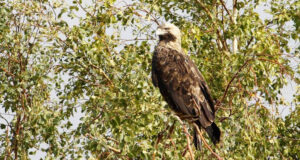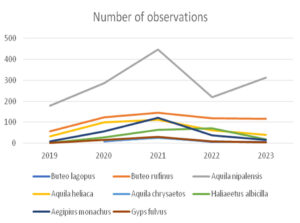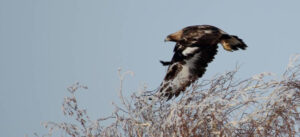Third International Scientific and Practical Conference “Eagles of the Palearctic: Study and Conservation”
Raptors Conservation. Suppl. 2. Proceedings of Conferences
MONITORING OF LARGE RAPTORS USING A SMART SYSTEM IN THE SOUTH OF KOSTANAY REGION, KAZAKHSTAN
Timoshenko A.Yu., Putilin A.V., Salemgareev R.R., Timoshenko G.Yu., Batyrkhanuly K. (Association for the Conservation of Biodiversity of Kazakhstan, Astana, Kazakhstan)
Contact:
Alexey Timoshenko alexey_timoshenko@acbk.kz
Alexander Putilin aleksandr.putilin@acbk.kz
Radik Salemgareev rad_1984@mail.ru
Georgy Timoshenko zhora.timoshenko88@gmail.com
Kanat Batyrkhanuly bat_kana@mail.ru
Recommended citation: Timoshenko A.Yu., Putilin A.V., Salemgareev R.R., Timoshenko G.Yu., Batyrkhanuly K. Monitoring of Large Raptors Using a Smart System in the South of Kostanay Region, Kazakhstan. – Raptors Conservation. 2023. S2: 165–167. DOI: 10.19074/1814- 8654-2023-2-165-167 URL: http://rrrcn.ru/en/archives/34993
There are many effective tools for collecting data on wildlife in world practice, and the SMART system is one of them. It allows us to gather and analyze information. SMART is used in more than 500 protected areas in 48 countries (implemented at the state level in a number of countries). The SMART method is based on the use of mobile application and a computer program; data is collected during field research and by SMART specialist during cameral processing. A smartphone with the SMART mobile app replaces paper forms and GPS navigator.
Since 2017, the system has been introduced for wildlife service in “Altybai” and “Saga” hunting services, which are assigned to the Association for the Conservation of Biodiversity of Kazakhstan (ACBK) and are located in the south of the Kostanay region. When raptor is encountered, employees record the following data in the SMART mobile application: species, gender, number, while the smartphone automatically records the track and GPS location, date, and time. It is possible to take photographs that can be linked to a specific observation and coordinated. In addition, the application has a “nest card” section developed by ASBK, which allows to record information about nests and their contents throughout the nesting cycle.
Having analyzed the data on encounters (number of registrations) of the most common large raptor species collected over the past five years, such as: Rough-Legged Buzzard (Buteo lagopus), Long-Legged Buzzard (Buteo rufinus), Steppe Eagle (Aquila nipalensis), Eastern Imperial Eagle (Aquila heliaca), Golden Eagle (Aquila chrysaetos), White-Tailed Eagle (Haliaeetus albicilla), Cinereous Vulture (Aegipius monachus) and Eurasian Griffon (Gyps fulvus), we can note that the peak number of observations occurred in 2021, when a decline was observed for most of the listed species, except for the Steppe Eagle and Long-Legged Buzzard.
Thus, the SMART system contains good tools for recording observations, with the ability to customize for specific purposes, allows you to prepare reports with maps, tables, and graphs, store a large amount of data and makes it possible to evaluate the group dynamics and trends for certain species by year.



